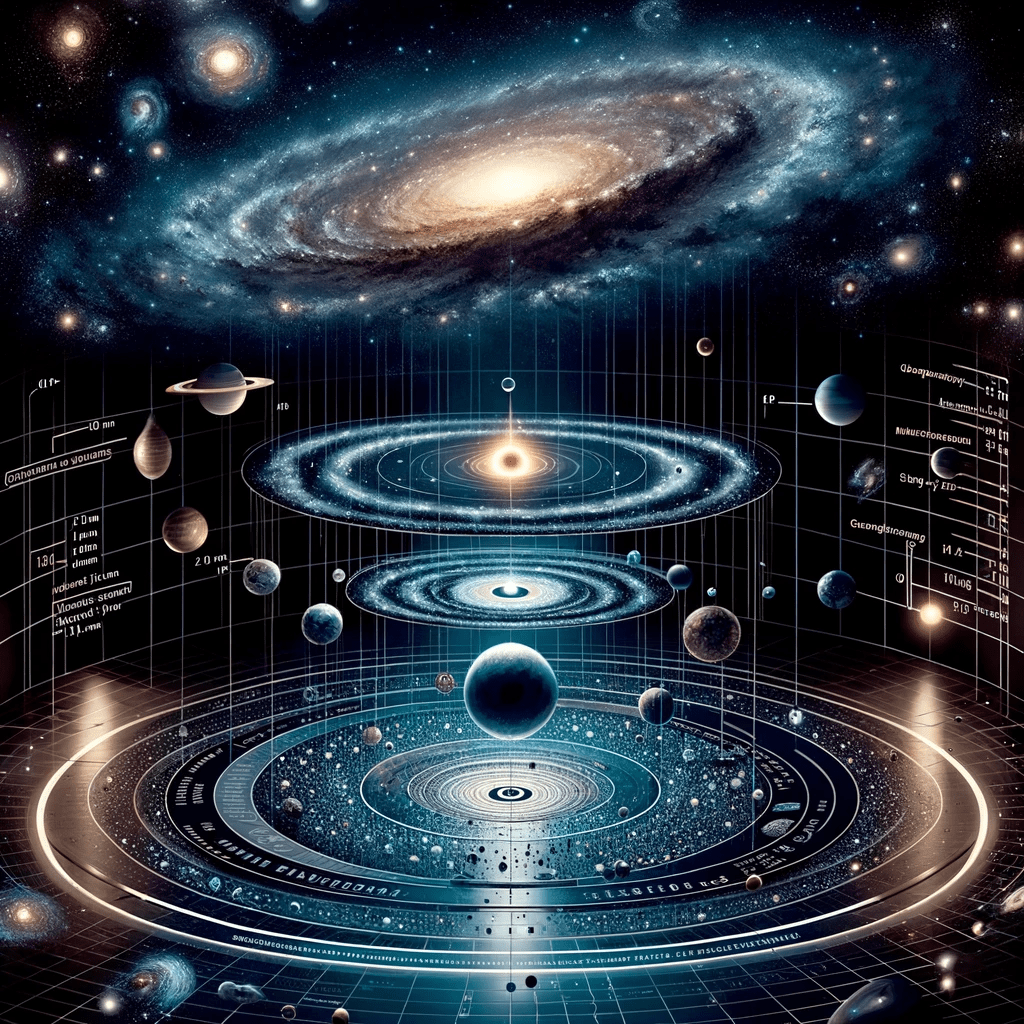The Scale of the Universe

The universe is an immense and intricate expanse, filled with objects ranging from subatomic particles to gargantuan celestial bodies. Have you ever gazed at the night sky and wondered just how far those tiny specks of light really are? The cosmos stretches beyond imagination, and understanding its scale is essential for grasping its enormity and complexity. Examining the scale of the universe reveals how the scale of the universe is measured, what it contains, and the profound implications of its vastness.
Measuring distances in the universe requires specialized units because conventional ones simply don’t suffice. The Astronomical Unit (AU) represents the average distance between Earth and the Sun, about 93 million miles or 150 million kilometers. Another commonly used measure is the light-year—the distance light travels in a year, roughly 6 trillion miles (9.46 trillion kilometers). Even larger distances are measured in parsecs, with one parsec equaling 3.26 light-years. Scientists also use Hubble’s Constant to determine the expansion rate of the universe, which is currently estimated at around 70 km/s/Mpc (kilometers per second per megaparsec). This expansion means galaxies are continuously drifting apart, stretching the very fabric of space-time itself.
The universe presents a paradox. While it holds endless possibilities, its vast distances act as a natural barrier, isolating civilizations within their cosmic neighborhoods. This limitation, combined with the universe’s predominantly cold, dark, and lifeless nature, reinforces the idea that Earth may function like a prison planet, confined by the sheer difficulty of interstellar travel. Even if we developed advanced propulsion systems, reaching the nearest star would still take thousands of years using our current technology.
The structure of the universe is astonishingly complex. It consists of a hierarchy that begins with superclusters, the largest known structures, which contain multiple galaxy clusters. Within these clusters are individual galaxies, each housing billions of stars. Stars, in turn, host planetary systems that contain planets, moons, asteroids, and comets. This intricate layering of cosmic structures provides a fascinating glimpse into the organization of the universe.
Stars are the building blocks of galaxies, vast spheres of hot gas primarily composed of hydrogen and helium. The closest stars to Earth include Proxima Centauri at 4.2465 light-years, Alpha Centauri A & B at 4.37 light-years, and Barnard’s Star at 5.96 light-years. These cosmic neighbors, while close in astronomical terms, are still impossibly far from human reach—at least with current technology. If future space travel advances dramatically, these stars may one day serve as destinations for interstellar exploration.
Galaxies, the colossal islands of the universe, are bound by gravity and come in various shapes such as spiral, elliptical, and irregular. The closest galaxies to the Milky Way include the Canis Major Dwarf Galaxy, located 25,000 light-years away, and the Sagittarius Dwarf Elliptical Galaxy, approximately 65,000 to 70,000 light-years away. The Large Magellanic Cloud, a satellite galaxy of the Milky Way, lies at a distance of 163,000 light-years. Within the Local Group, a cluster of about 50 galaxies, these cosmic structures form an interconnected web of stars and dark matter. Ursa Major II Dwarf Galaxy, previously thought to be 230,000 light-years away, is now estimated to be about 32,100 light-years away, highlighting how astronomical measurements continue to evolve.
Black holes are perhaps the most mysterious objects in the universe. These regions of space have gravitational pulls so strong that nothing—not even light—can escape them. Black holes come in three types: stellar-mass black holes, which form from collapsing stars, intermediate black holes, and supermassive black holes, which are found at the centers of galaxies. Some of the closest black holes to Earth include V616 Monocerotis, located approximately 3,000 to 4,700 light-years away, Cygnus X-1 at 6,070 light-years, and V404 Cygni at 7,800 light-years. Other black holes such as GX 339-4 are estimated to be 34,300 light-years away instead of the previously listed 26,000, and IGR J17091-3624 is now thought to be around 28,000 light-years away rather than 16,000. These monstrous entities continue to be subjects of intense study, as they may hold the key to understanding space-time itself.
Dark matter, a substance that does not emit or interact with light, remains one of the universe’s greatest mysteries. Though invisible, its gravitational effects shape galaxies and even the universe’s large-scale structure. It is estimated to make up about 27% of the universe’s total mass-energy content, yet scientists have yet to determine its exact composition. Without dark matter, galaxies would not have enough gravity to hold themselves together.
Despite all that we can measure and observe, some researchers suggest that the physical universe is just a fraction of a much larger reality. The idea that we exist in a multi-dimensional framework has gained traction in both theoretical physics and spiritual traditions. String theory, for example, posits that the universe may consist of at least ten dimensions, most of which are hidden from our direct perception. Similarly, quantum physics experiments, such as the famous double-slit experiment, suggest that reality is influenced by observation, hinting at the idea that consciousness itself may interact with dimensions beyond the observable.
Ancient philosophies and esoteric traditions have long held that human consciousness transcends physical limitations, existing across multiple planes of reality. Near-death experiences, psychedelic visions, and reports of out-of-body travel provide anecdotal evidence that there may be more to existence than what our five senses reveal. If we indeed exist as multi-dimensional beings, then what we perceive as the universe is merely a sliver of a much grander existence—one shaped by our limited sensory experience and current scientific comprehension.
To grasp the true vastness of the universe, consider this analogy. Imagine Earth as the size of a grain of sand. In this scenario, the Sun would be a grapefruit placed about 15 meters away. The nearest star, Alpha Centauri, would be thousands of miles away, and the Milky Way would span a distance equivalent to multiple Earth circumferences. Andromeda, our closest large galactic neighbor, sits 2.5 million light-years away—a distance that boggles the human mind. The sheer emptiness of space between objects is staggering, making interstellar travel a nearly insurmountable challenge with our current level of technology.
Observing the universe means looking into the past. Since light takes time to travel, what we see in the night sky is actually an image of the past. When we observe the Andromeda Galaxy, we are seeing it as it was 2.5 million years ago. Some of the most distant galaxies we observe today appear as they did billions of years ago, providing insight into the universe’s infancy. In a way, telescopes are time machines, allowing us to peer into the cosmos’s history and witness the evolution of the universe itself.
Despite remarkable technological advances, the universe remains largely beyond our reach. The immense distances and harsh conditions make interstellar travel an extraordinary challenge. The cosmos, in its sheer enormity, acts as a walled garden, limiting our ability to traverse beyond our solar system. And yet, within this cosmic isolation, there is immense beauty. Each star, galaxy, and black hole tells a story of time, space, and the fundamental forces that govern the universe. If the physical universe is only part of the equation, then what explains the countless reports of UFOs, encounters with seemingly supernatural beings—both benevolent and malevolent—and the widespread human experiences with psychic phenomena? If our reality is shaped by more than what we can see and measure, then the nature of existence itself may be more extraordinary than we ever imagined. The more we explore, the more we uncover not just about the cosmos, but about ourselves. The universe is an endless frontier, and perhaps, so is human consciousness.


